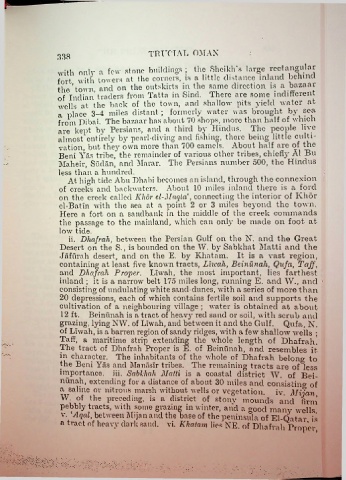Page 322 - A Hand book of Arabia Vol 1 (iii) Ch 6 -10
P. 322
TRITTAL OMAN (
338
with only a few stone buildings ; the Sheikh s large rectangular
fort with towers at the corners, is a little distance inland behind
the ’ town and on the outskirts in the same direction is a bazaar
Indian’traders from Tatta in Sind. There are some indifferent-
of
the back of the town, and shallow pits yield water at-
sea
a place 3-4 miles distant ; formerly water was brought by
from Dibai. The bazaar has about 70 shops, more than half of which
are kept by Persians, and a third by Hindus. The people live
almost entirely by pearl-diving and fishing, there being little culti
vation, but they own more than 700 camels. About half are of the
Beni Yas tribe, the remainder of various other tribes, chiefly Al Bu
Maheir, Sudan, and Marar. The Persians number 500, the Hindus
less than a hundred.
At high tide Abu Dhabi becomes an island, through the connexion
of creeks and backwaters. About 10 miles inland there is a ford
on the creek called Khor el-Maqla', connecting the interior of Khor
el-Batin with the sea at a point 2 or 3 miles beyond the town.
Here a fort on a sandbank in the middle of the creek commands
the passage to the mainland, which can only be made on foot at
low- tide.
ii. Dhafrah, between the Persian Gulf on the N. and the Great
Desert on the S., is bounded on the W. by Sabkhat Matt-i and the
Jafurah desert, and on the E. by Kliatam. It is a vast region,
containing at least five known tracts, Lhcah, Beinunah, Qufa, Toff,
and Dhafrah Proper. Lnvah, the most important, lies farthest
inland ; it is a narrow’ belt 175 miles long, running E. and W., and 1
consisting of undulating white sand-dunes, with a series of more than
20 depressions, each of which contains fertile soil and supports the
cultivation of a neighbouring village ; water is obtained at about
12 ft. Beinunah is a tract of heavy red sand or soil, with scrub and
grazing, lying NW. of Llwah, and between it and the Gulf. Qufa, N.
of Llwah, is a barren region of sandy ridges, with a few’ shallow w’ells ;
Taff, a maritime strip extending the whole length of Dhafrah!
The tract of Dhafrah Proper is E. of Beinunah, and resembles it
in character. The inhabitants of the whole of Dhafrah belono- to
the Beni Yas and Manaslr tribes. The remaining tracts are of^less
importance, hi. Sabkhah Matti is a coastal district W. of Bei
nunah, extending for a distance of about 30 miles and consisting of
a saline or nitrous marsh without wells or vegetation, iv Milan
W. of the preceding, is a district of stony mounds and firm
pebbly tracts, with some grazing in winter, and a good many wells
v. Aqal, between Mijan and the base of the peninsula of El-Qatar is
a tract of heavy dark sand. vi. Khatam lies N.E. of Dhafrah Proper
* - •
x:

